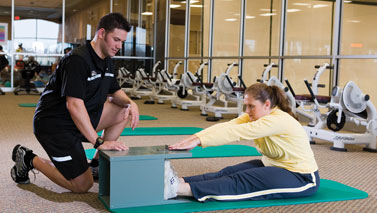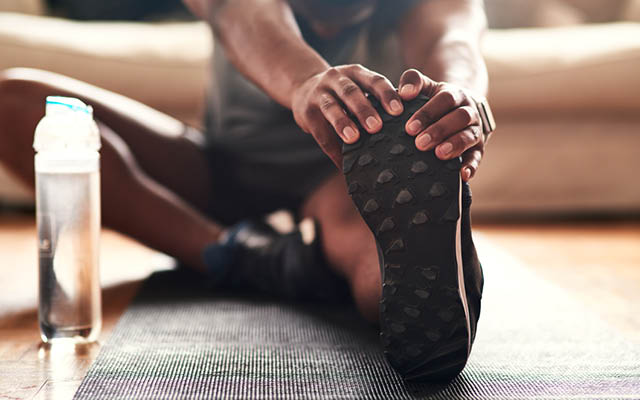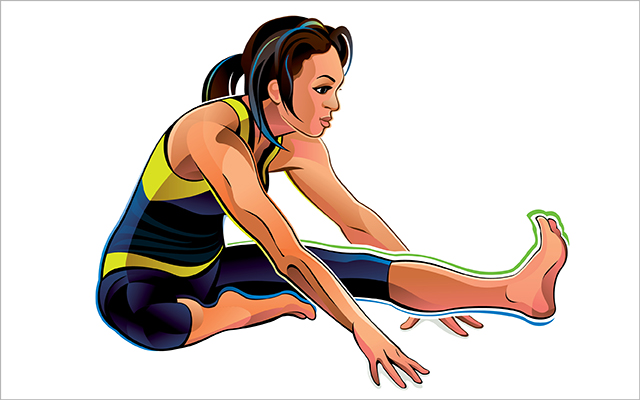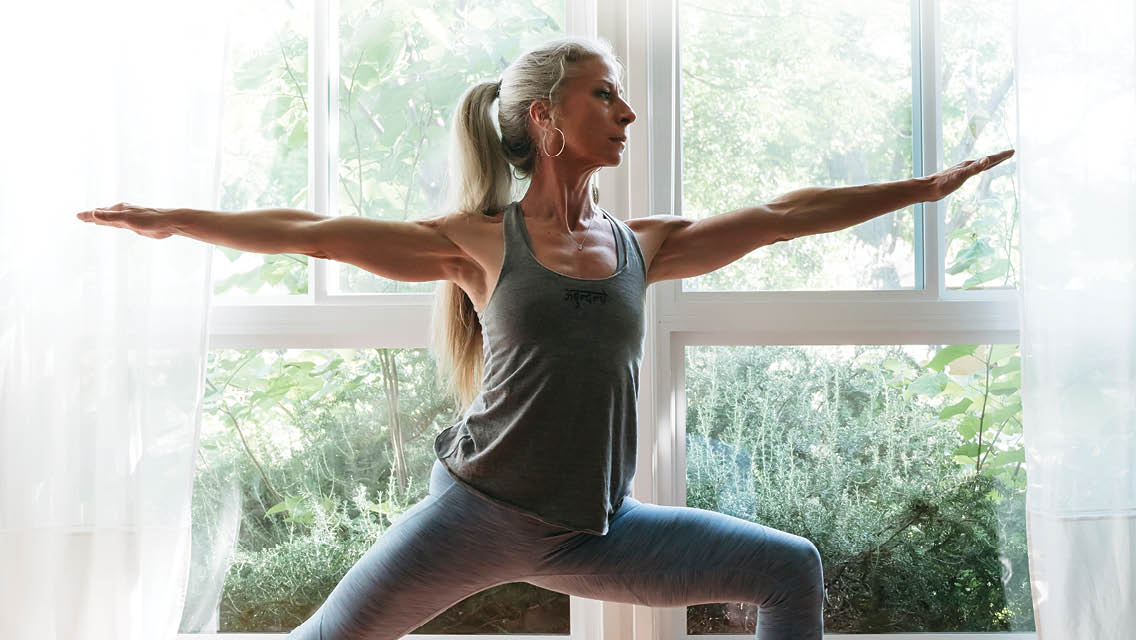This article is the last in a three-part series that explores the methods and benefits of fitness testing for strength, cardio and flexibility – just a few of the many types of assessments available through health clubs, training centers and sports clinics. See part one “Fitness Testing 1, 2, 3: Strength in Numbers” and part two “Fitness Testing 1, 2, 3: Cardio Capacity” and
Fitness testing can help anyone work out more efficiently and get better results more quickly. That’s because knowing your results allows you to create a workout plan that takes into account your current level of fitness, as well as your fitness goals.
Flexibility, covered in this article, is the most often overlooked component of the fitness triangle. Yet it’s as key to your overall fitness as cardiovascular and strength training. Good flexibility helps you avoid injury; it improves posture and ergonomics; and, because it allows for a better range of motion, it may enhance your motor performance and skill execution.
We asked personal trainer Derk Voskuil, a metabolic training specialist at the Life Time Fitness health club in Chanhassen, Minn., to put three people with very different fitness goals through a series of flexibility tests. Here, we report on the participants’ experiences with those tests, including Voskuil’s recommendations based on their current state of flexibility. Having focused on Todd Carstensen’s strength results in April and Melissa Gonzalez’s cardio-based weight-loss goals in May, we turn our attention this month to 52-year-old John Tanner, whose age and goals emphasize the importance of flexibility.
Meet the Participants
To get a sense of how folks from diverse fitness backgrounds with different fitness goals might apply fitness-testing results to their advantage, we asked Life Time Fitness personal trainer Derk Voskuil to work with the following three individuals as they progressed through a series of evaluations in the areas of strength, cardiovascular fitness and flexibility.
Todd Carstensen, 38: General contractor
FITNESS OBJECTIVES: To build up enough bulk and strength to resume playing the recreational hockey he loved in college but then abandoned because of back pain.
Melissa Gonzalez, 37: Compliance analyst for insurance company, mother of two
FITNESS OBJECTIVES: To slim down and increase her energy so she can spend more time playing with her kids.
John Tanner, 52: Manager of IT consultants
FITNESS OBJECTIVES: To maintain his fitness level, improve flexibility and reduce his susceptibility to heart disease, which runs in his family.
Derk Voskuil: Personal Trainer, Life Time Fitness
Voskuil is a CPT with nine years of experience in the field. He specializes in the science of metabolic training and holds a degree in exercise science with an emphasis in strength conditioning from the University of Wisconsin-La Crosse.
John Tanner
Body Specs: 6 feet 1 inch, 220 pounds
Goal: To maintain a feel-good level of fitness and flexibility, and to ward off potential heart problems.
Obstacle: Fitting fitness into a busy schedule.
Fitness Background: Tanner knows focusing on fitness will help him stay active as he ages, but to date, he hasn’t developed a fitness strategy. His training schedule is erratic, with cardio sessions that don’t challenge his heart rate, and weight-training sessions that leave him exhausted.
Postural Analysis: Shoulder extension angle: 108 degrees. Hip flexion: 56 degrees. Knee angle when squatting: 67 degrees. Voskuil’s evaluation: above average overall, with good general posture; some rotator cuff tightness.
Sit and Reach: 9 3/4 inches; below average, according to American College of Sports Medicine (ACSM) standards.
Trainer Recommendations: Tanner’s postural-analysis numbers are a little above average. He can continue to improve his range of motion by focusing on flexibility even when he’s doing resistance and cardio training. For example, he can take care to fully extend his arms with each biceps curl.
His below-average sit-and-reach score indicates that he needs to do some similar range-of-motion training for his lower body. Targeted exercise, such as full-range-of-motion light squats, can improve flexibility by as much as 20 to 30 percent.
Voskuil recommended 15 general moves for Tanner to improve lower-body flexibility, especially in his quads, hips and calves. As Tanner progresses, Voskuil will pinpoint other areas for him to focus on.
“An optimal range of motion,” Voskuil says, “reinforces good health and good mechanics.” Voskuil also recommended that Tanner take a yoga class a couple of times a month. This will help keep his routine fresh, improve his balance and help him learn how to relax – a key component to flexibility.
Takeaway Wisdom: As Tanner ages, his muscles will take longer to return to resting length. He’ll need to warm up fully and work with greater focus on moving through his full range of motion as often as possible. The good news is that age does not impede a muscle’s ability to stretch. With practice, Tanner will eventually be able to accomplish his goal of touching his palms to the floor in a forward bend. “If John extends his range of motion,” Voskuil says, “there shouldn’t be any limit to what he can do.”
Todd Carstensen
Body Specs: 6 feet 1 inch, 190 pounds
Goal: To bring his fitness – and his hockey-playing capacity – back to his college-era levels.
Obstacle: Back pain and years of taking it too easy at the gym.
Fitness Background: Carstensen has been bothered by back pain since age 18, when he learned he had bulging discs. He longs to play recreational hockey like he did in college and also wishes he could haul lumber and shingles with more ease at his job. For almost a decade, Carstensen’s workouts have consisted mainly of stretching in the hot tub or sauna to relieve pain.
Postural Analysis: Shoulder extension angle: 112 degrees. Hip flexion: 67 degrees. Knee angle when squatting: 88 degrees. Voskuil’s evaluation: Flexibility and posture need work overall; pronounced limitations in the shoulders and hips.
Sit and Reach: 6 inches; well below average, according to ACSM standards.
Trainer Recommendations:Voskuil noticed that Carstensen stood with a slight slouch, so the postural-analysis numbers and the pronounced limitations in the shoulders and hips came as no surprise. (Poor posture can decrease flexibility.) Voskuil advised Carstensen to hold off on additional strength training until his flexibility improves.
Because Carstensen is getting back into athletics, his flexibility regimen, as well as his cardio and strength-training programs, will be more intense than Tanner’s and Gonzalez’s. “He’ll need an optimum range of motion all over,” Voskuil says. Carstensen will go through a series of about 30 moves, focusing especially on those for the spine and shoulders – in all, spending half an hour a day on flexibility. He should also take a yoga class twice a month to add range and variety to his flexibility training.
Takeaway Wisdom: Carstensen has had back surgery and, more recently, hernia surgery. Reconditioning scar tissue will be a priority, as it tends to resist stretching more than that of normal, healthy tissue. “Your tightest muscle will restrict you,” Voskuil says. “You need to break up scar tissue and allow it to reheal and realign in a pattern that works with the muscle.”
Ideally, Carstensen will start a therapeutic regimen with a physical therapist. A personal trainer can build from that base.
Melissa Gonzalez
Body Specs: 5 feet 7 inches, 195 pounds
Goal: To lose weight and increase energy so she can enjoy active time with her kids.
Obstacle: Finding time. Gonzalez works from home, but travels a lot and doesn’t schedule fitness time into her week.
Fitness Background: Gonzalez is a working mom who wants to run and play with her 3- and 6-year-old sons. She also needs to be able to perform daily household tasks without back pain. She knows that improving her fitness level is important, but she’s been unable to stick with previous attempts to work in regular walks and aerobics classes for more than a week or two.
Postural Analysis: Shoulder extension angle: 180 degrees. Hip flexion: 80 degrees. Knee angle when squatting: 90 degrees. Voskuil’s evaluation: Above average posture and flexibility, with an “ideal” rating in shoulder extension.
Sit and Reach: 51/2inches; well below average, according to ACSM standards.
Trainer Recommendations: Although Gonzalez has been sedentary for years, she is quite flexible, with the exception of her hamstrings. Unlike Tanner and Carstensen, who gingerly lifted their arms above their heads during the shoulder analysis, Gonzalez easily swung her arms up. Voskuil attributes this to her correct natural posture.
To maintain her flexibility, Gonzalez will start with the same set of stretches that Tanner is using, but she’ll focus more on hamstrings since her sit-and-reach test indicated excessive tightness there. Because Gonzalez travels a lot, Voskuil encourages her to continue her stretching routine on the road. The only equipment she’ll need for her routine is a stability ball, but she can modify the exercises if she doesn’t have access to one in her hotel.
Takeaway Wisdom: By focusing on her hips, lower back and legs, Gonzalez should reduce her back pain, Voskuil says. She’ll be able to bend, stoop, squat – even walk – more easily.
Testing Methods
Personal trainer Derk Voskuil tests overall flexibility with a postural-analysis test that can pinpoint causes of spine, back, neck, or other local or generalized pain. He uses the sit-and-reach test as a benchmark for hamstring elasticity.
In order for muscles to remain healthy, Voskuil says, they must maintain a full range of motion. A knowledgeable trainer will be able to discern a lot about your strength and flexibility just by the way you naturally stand. The trainer can use postural analysis to decide what exercises are appropriate by identifying any mobility limitations.
For the analysis, the personal trainer will ask you to stand facing away from a wall, feet shoulder-width apart, heels about a foot away from the wall. Then, leaning back so that your buttocks, shoulders and head press against the wall, you’ll align your spine flat against it. As you slowly lift your arms, the trainer will note when your back starts to pull away from the wall. The trainer will then measure the degree of your shoulder extension and identify areas of stiffness.
To measure hip and knee flexion, you’ll get into a squatting position (without wall support). The trainer will measure the angle of your hips and knees when you reach the deepest point in your squat while keeping your heels on the floor.
You may remember the sit-and-reach test from middle school gym classes: Sitting on the floor with both legs extended in front of you, you place your feet (shoes off) against a “sitand- reach table” (essentially a 12- inch-tall box with a measuring stick on top). You stretch your arms and upper body forward as far as possible while keeping your legs perfectly straight; the results are measured by how far you can reach your fingertips – without bouncing. The test measures the flexibility of your hamstrings and low back – and people very often underestimate how much they use those muscles. Flexible hamstrings, Voskuil says, are crucial for avoiding lower-back issues.
Fees for similar testing are based on personal-training hourly rates, which typically range from $59 to $99 at Life Time Fitness.





This Post Has 0 Comments